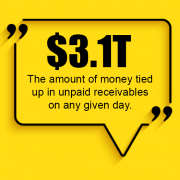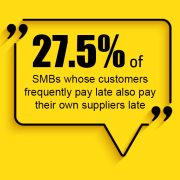Cash Flow Problems or Business Challenges – Which Came First?
Whether or not you deploy invoice factoring or other financing tools to resolve cash flow problems, drill down to the root of the problem to prevent it from impacting your growth again in the future.
Cause or Effect? Exploring the Relationship of Common Business Challenges and Cash Flow Problems
“Access to capital” is commonly cited among the top cash flow problems for small business owners and startups. But often, slow cash flow is a symptom, not the cause.
Earlier, we published an article listing the top ten reasons B2B startups fail – or fail to thrive – during their early years. While “access to working capital” was not explicitly listed among the reasons, many of the reasons that these small businesses failed tie back to cash flow problems in some way. So much so that someone on LinkedIn asked why “access to capital” was not on the list:
“Good info to share. I have read several articles that say the #2 reason for failure is the lack of revenue / cash flow / financing.”
Is inadequate cash flow the cause or just the symptom when things are going sideways in a B2B startup or young business? This is a classic “which came first, the chicken, or the egg?” type of question. It’s easy to point to lack of working capital or slow cash flow as the problem, when actually, cash flow problems are the result of another issue whose roots lie elsewhere.
Here’s another look at the list we shared, along with an analysis of what symptoms might be present within a business experiencing the same type of challenge. We also share some steps you can take to address the challenges.
More than Cash Flow Problems: Warning Signs of the Top 10 Challenges that Derail Startups and Small Businesses
Emotional Pricing and Not Understanding Your Pricing (#1 and #4 on the list)
When goods or services aren’t priced high enough to produce the margins needed for a business to be profitable. Conversely, products priced too high can result in inadequate sales volumes and revenues required to meet operational needs. Both cases result in low cash flow and an unsustainable business model.
You may be able to fix your pricing strategy by conducting some competitive research or establishing a value proposition that resonates with more buyers. Determine whether there is an adequate number of buyers in your target markets to support a particular product or service. If the market is inadequate, it might be necessary to scrap or table the item for the time being, or find a new market for your product.
Living Too Large (#2 on the list)
Many entrepreneurs become small business owners out of a desire to build a better life for themselves. They often want to enjoy the fruits of their labor as quickly as possible. Low cash flow can be symptomatic of the removal of too much operating revenue by an owner or investors. (I knew a store owner whose spouse would come to the store and take money directly out of the till for personal use. It didn’t take long for the business owner to be forced to sell the business at a fire-sale price.)
Proper financial planning and having transparent cash controls can help to ensure that the business retains the revenues it needs for day to day operations and growth initiatives. Best practices suggest you separate personal and business finances, even as a sole proprietor.
Not Paying Taxes and No Experience in Record-Keeping (#3 and #7 on the list)
Most tax preparation professionals can share at least one story about doing taxes for a small business owner who had failed to set aside money for payroll, state, or federal taxes. Not paying taxes at all, or not paying enough in taxes is a sure-fire way to hurt a small business.
Inadequate or sloppy record-keeping often combines with non-payment of taxes. Both issues can be fixed by working with a professional accountant or bookkeeper in order to ensure that the paperwork is done right and taxes are filed and paid on time.
Shoddy record keeping often hides the root causes of low cash flow. And , it’s important to include projected tax expenses as you calculate margins and set prices for your goods or services.
Lack of Planning (#5 on the list)
Want an easy way to negatively impact your numbers? Lack of planning. What can happen? You stock too much or too little inventory, resulting in price reductions or missed sales opportunities. Too many or too few staff members can make payroll numbers balloon. Materials costs skyrocket with rush charges because you didn’t order raw materials soon enough. Missed deadlines mean lost clients and sales. Some small business owners are inherent planners, others are more inclined to be visionaries. Some see the big picture, others the details.
One important thing for any business leader to remember is that it’s rare for any one person to have all the skills needed to do everything well. Solve this challenge by hiring to your inadequacies, finding good mentors, and recognizing where you need help. Pull your team together to lean on each other’s strengths.
The bottom line: If planning in many or even just one vital area of your business is not your strong suit, don’t be afraid to ask for help.
No Understanding of Financing and Inadequate Borrowing (#6 and #10 on the list)
Meet with a business finance expert as you launch your organization and as you grow. A specialist can help to ensure that your finances will be correctly set up and understandable. Clarity in this area can help you identify problems as they emerge before they hurt your business, and while there is still time to act to resolve them.
Additionally, it’s important for small business owners and entrepreneurs to understand that there are financing alternatives available that can help resolve common cash flow challenges. For instance, Corsa Finance partners with business financing professionals who can help small businesses with low or slow cash flow. Options include cash flow loans and invoice factoring that allow companies to “speed up” collection of customer invoices in order to create more consistent cash flow and take on new business more quickly.
Poor Credit Granting Practices (#8 on the list)
As with setting prices, organizations can make the mistake of extending terms that are too generous. Alternatively, if payment terms are too tight, customers may look for competitors with more lenient payment options.
Good news for companies that invoice their customers after delivering goods or performing services! Invoice factoring can alleviate this challenge altogether. When companies factor invoices, they can receive payment the same day the invoice is generated without waiting for customers to pay. The factoring company will do the waiting while you’re growing your business.
Expanding Too Fast (#9 on the list)
When organizations try to expand too quickly, they often deplete resources (including working capital) to the point that the business may have trouble meeting operating expenses. This is another instance where simply working with a financial expert and creating a thoughtful growth plan can prevent the problem from occurring.
***














